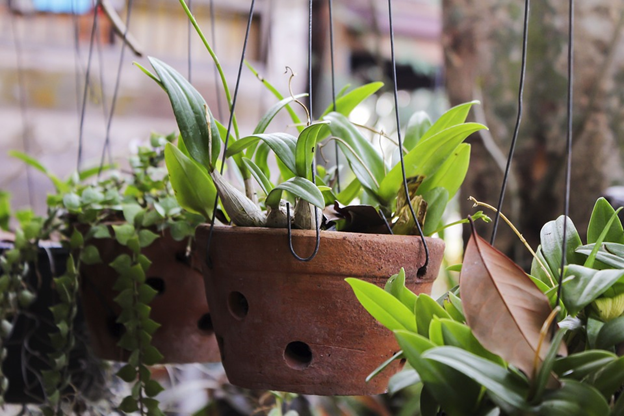
Kids thrive in spaces that feel alive, and plants bring a playful yet calming energy to any room. Beyond their vibrant appearance, the greenery can purify the air, spark curiosity about nature, and create an inviting atmosphere for play.
But not all plants suit active little hands or busy play zones. Choosing ones that balance durability with design is key to blending fun and functionality.
Let’s explore seven standout plant options perfect for transforming kids’ playrooms into lively indoor jungles.
- Spider Plant
Spider plants are a favorite for families with kids. Their arching green-and-white leaves look playful, and they’re incredibly low-maintenance. Even in dim corners, these plants thrive without constant care.
Kids love watching the “spiderettes,” or baby offshoots, dangle-like decorations. You can pot them up or leave them hanging to add texture to the space’s design. Plus, they act as natural air purifiers, keeping the space fresh.
Pairing spider plants with tall planters elevates their cascading leaves.
- Parlor Palm
Kids could also benefit from the gentle tropical vibe of a parlor palm. Its feathery fronds bring softness to playrooms without feeling overpowering.
Parlor palm grows slowly and stays compact, so you won’t need to worry about frequent repotting or taking up too much floor space. The non-toxic nature makes it safe around little ones while still providing a touch of greenery.
Its ability to thrive in indirect light makes it versatile for any room layout. To create a calming environment, you could place parlor palms near a cozy play corner or reading nook.
- Calathea Medallion
Another popular option is the Calathea Medallion, known for its striking, patterned leaves that almost look painted. The bold green and purple tones can liven up any interior while sparking kids’ interest in nature’s unique designs.
It thrives in humid environments with low to medium light, making it an ideal choice for indoor spaces where sunlight doesn’t dominate. Regular misting keeps it happy and vibrant, creating an opportunity for children to help care for it.
Calathea Medallion can be placed on shelves, low tables, or even inside decorative pots to match the room’s playful vibe.
- Pilea Peperomioides
Known as the Chinese Money Plant, Pilea Peperomioides brings charm with its round, coin-like leaves. Its compact size makes it excellent for tiny rooms or window sills within kids’ reach.
The plant grows quickly in bright, indirect light and is easy to propagate. Little ones can enjoy planting the offshoots themselves, fostering an early connection to gardening and care routines.
The Chinese Money Plant is also safe for pets. The unique shape of its leaves adds a playful touch to the space, blending well with colorful toys and decor.
- Dwarf Banana Tree
To bring a touch of the tropics to kids’ rooms, consider adding a Dwarf Banana. This plant is not only visually stunning but also functional, improving air quality by releasing oxygen and filtering toxins.
Non-toxic and safe for little hands, the Dwarf Banana Tree thrives with regular watering and bright light. The care routine can encourage kids to take responsibility in a fun way, fostering patience as they watch it grow.
Beyond aesthetics, this plant naturally humidifies indoor air. It’s especially beneficial in drier seasons or climates, promoting healthier skin and breathing for everyone in the space.
- Fittonia
Fittonia, often called the Nerve Plant, boasts intricate leaf patterns with vibrant veins that can catch a child’s attention instantly. Its small size makes it perfect for desks or small tables in a playroom setting.
Children may enjoy its tactile leaves and bold colors, which create an interactive experience beyond just looking at greenery. It offers an engaging way to teach kids about plant anatomy and care practices.
The Nerve Plant pairs beautifully with decorative pots or terrariums for added flair. Its low height ensures it fits snugly into shared spaces without interfering with active play areas nearby.
- Boston Fern
Lastly, the Boston Fern adds a touch of classic greenery to any kid’s space. With lush, cascading fronds, it creates a texture that can bring life to otherwise static spaces.
The fern’s bushy appearance makes it ideal for softening sharp corners or filling gaps in the room’s design. Kids often enjoy brushing their hands through its feathery leaves, offering a sensory element within the space.
Boston Ferns work wonderfully in hanging baskets or raised planters, keeping them out of the way while maintaining their visual charm. Their graceful presence can create a cozy and inviting atmosphere where kids feel relaxed and inspired to play or read.
Conclusion
For those interested in expanding children’s interaction with plants beyond playrooms, teaching them about gardening can be enriching. Consider engaging them with simple gardening projects, like learning rose planting tips, which can foster a love for nature.
Incorporating greenery transforms play spaces into vibrant ecosystems. Whether it’s the quirky leaves of a Pilea or the elegance of a Boston Fern, these plant companions enrich children’s environments and spark joy daily. Embrace this natural touch to nurture both creativity and growth in your little ones’ everyday adventures.


